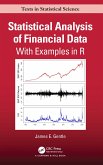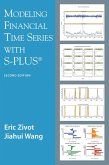Xin Guo, Tze Leung Lai, Howard Shek, Samuel Po-Shing Wong
Quantitative Trading
Algorithms, Analytics, Data, Models, Optimization
Xin Guo, Tze Leung Lai, Howard Shek, Samuel Po-Shing Wong
Quantitative Trading
Algorithms, Analytics, Data, Models, Optimization
- Gebundenes Buch
- Merkliste
- Auf die Merkliste
- Bewerten Bewerten
- Teilen
- Produkt teilen
- Produkterinnerung
- Produkterinnerung
The first part of this book discusses institutions and mechanisms of algorithmic trading, market microstructure, high-frequency data and stylized facts, time and event aggregation, order book dynamics, trading strategies and algorithms, transaction costs, market impact and execution strategies, risk analysis, and management. The second part covers market impact models, network models, multi-asset trading, machine learning techniques, and nonlinear filtering. The third part discusses electronic market making, liquidity, systemic risk, recent developments and debates on the subject.
Andere Kunden interessierten sich auch für
![Statistical Analysis of Financial Data Statistical Analysis of Financial Data]() James GentleStatistical Analysis of Financial Data154,99 €
James GentleStatistical Analysis of Financial Data154,99 €![An Introduction to Computational Risk Management of Equity-Linked Insurance An Introduction to Computational Risk Management of Equity-Linked Insurance]() Runhuan FengAn Introduction to Computational Risk Management of Equity-Linked Insurance154,99 €
Runhuan FengAn Introduction to Computational Risk Management of Equity-Linked Insurance154,99 €![C++ for Financial Mathematics C++ for Financial Mathematics]() John ArmstrongC++ for Financial Mathematics127,99 €
John ArmstrongC++ for Financial Mathematics127,99 €![R Programming and Its Applications in Financial Mathematics R Programming and Its Applications in Financial Mathematics]() Shuichi OhsakiR Programming and Its Applications in Financial Mathematics200,99 €
Shuichi OhsakiR Programming and Its Applications in Financial Mathematics200,99 €![Financial Mathematics Financial Mathematics]() Giuseppe CampolietiFinancial Mathematics153,99 €
Giuseppe CampolietiFinancial Mathematics153,99 €![Data Analytics for Finance Using Python Data Analytics for Finance Using Python]() Nitin Jaglal UntwalData Analytics for Finance Using Python154,99 €
Nitin Jaglal UntwalData Analytics for Finance Using Python154,99 €![Modeling Financial Time Series with S-Plus(r) Modeling Financial Time Series with S-Plus(r)]() Eric ZivotModeling Financial Time Series with S-Plus(r)122,99 €
Eric ZivotModeling Financial Time Series with S-Plus(r)122,99 €-
-
-
The first part of this book discusses institutions and mechanisms of algorithmic trading, market microstructure, high-frequency data and stylized facts, time and event aggregation, order book dynamics, trading strategies and algorithms, transaction costs, market impact and execution strategies, risk analysis, and management. The second part covers market impact models, network models, multi-asset trading, machine learning techniques, and nonlinear filtering. The third part discusses electronic market making, liquidity, systemic risk, recent developments and debates on the subject.
Hinweis: Dieser Artikel kann nur an eine deutsche Lieferadresse ausgeliefert werden.
Hinweis: Dieser Artikel kann nur an eine deutsche Lieferadresse ausgeliefert werden.
Produktdetails
- Produktdetails
- Verlag: CRC Press
- Seitenzahl: 357
- Erscheinungstermin: 15. Dezember 2016
- Englisch
- Abmessung: 241mm x 161mm x 25mm
- Gewicht: 704g
- ISBN-13: 9781498706483
- ISBN-10: 1498706487
- Artikelnr.: 47445938
- Herstellerkennzeichnung
- Libri GmbH
- Europaallee 1
- 36244 Bad Hersfeld
- gpsr@libri.de
- Verlag: CRC Press
- Seitenzahl: 357
- Erscheinungstermin: 15. Dezember 2016
- Englisch
- Abmessung: 241mm x 161mm x 25mm
- Gewicht: 704g
- ISBN-13: 9781498706483
- ISBN-10: 1498706487
- Artikelnr.: 47445938
- Herstellerkennzeichnung
- Libri GmbH
- Europaallee 1
- 36244 Bad Hersfeld
- gpsr@libri.de
Xin Guo is the Coleman Fung Chair Professor of Financial Modeling in the department of Industrial Engineering and Operations Research, UC Berkeley. She founded the Berkeley Risk Analysis and Data Analytics Research (RADAR) Lab and holds a courtesy appointment with the Lawrence Berkeley National Lab. Prior to UC Berkeley, she was a Research Staff Member at the IBM T. J. Watson Research Center and an Associate Professor at Cornell University. Her main research interests are stochastic control, stochastic processes and applications. In addition to high frequency trading modeling and analysis, her recent research includes singular controls, impulse controls, non-linear expectations, mean-field games, and filtration enlargement with application to credit risk. Tze Leung Lai is a Professor of Statistics and, by courtesy, of Health Research and Policy in the School of Medicine and of the Institute for Computational & Mathematical Engineering (ICME) in the School of Engineering at Stanford University. He is Director of the Financial and Risk Modeling Institute, Co-Director of the Biostatistics Core of the Stanford Cancer Institute, and Co-Director of the Center for Innovative Study Design at the Stanford School of Medicine. He has held regular and visiting faculty appointments at Columbia University, UC Berkeley, and Nankai University, and holds advisory positions with the University of Hong Kong, Peking University, and Tsinghua University. Howard Shek is a senior researcher at Tower Research Capital, where he has built and led the Core Research team with a mandate that covers the wide spectrum of research topics in automated trading. He has over 15 years of quantitative research and trading experience in fixed-income arbitrage, market microstructure, volatility estimation, option pricing, and portfolio theory, and has held senior trading and research positions at Merrill Lynch and J. P. Morgan, focusing on proprietary trading in fixed-income derivatives. Samuel Po-Shing Wong is CEO and Chief Quant of 5Lattice Securities, a proprietary trading company in Hong Kong that develops quantitative trading algorithms and corresponding risk management methodologies from statistical data analysis and machine learning. He also teaches the course of Algorithmic Trading for Stanford Quantitative Finance Program in Hong Kong and serves as an Honorary Professor of the Department of Statistics and Actuarial Science at The University of Hong Kong.
Introduction Evolution of trading infrastructure Quantitative strategies
and time-scalesStatistical arbitrage and debates about EMH Quantitative
funds, mutual funds, hedge fundsData, analytics, models, optimization,
algorithms Interdisciplinary nature of the subject and how the book can be
used Supplements and problems Statistical Models and Methods for
Quantitative Trading Stylized facts on stock price data Time series of
low-frequency returnsDiscrete price changes in high-frequency dataBrownian
motion at the Paris Exchange and random walk down Wall Street MPT as a
\walking shoe down Wall Street Statistical underpinnings of MPT Multifactor
pricing models Bayes, shrinkage, and Black-Litterman
estimatorsBootstrapping and the resampled frontierA new approach
incorporating parameter uncertainty Solution of the optimization problem
Computation of the optimal weight vector Bootstrap estimate of performance
and NPEBFrom random walks to martingales that match stylized facts From
Gaussian to Paretian random walksRandom walks with optional sampling
timesFrom random walks to ARIMA, GARCH Neo-MPT involving martingale
regression modelsIncorporating time series e_ects in NPEB Optimizing
information ratios along e_cient frontier An empirical study of neo-MPT
Statistical arbitrage and strategies beyond EMH Technical rules and the
statistical backgroundTime series, momentum, and pairs trading strategies
Contrarian strategies, behavioral _nance, and investors' cognitive
biases From value investing to global macro strategies In-sample and
out-of-sample evaluationSupplements and problems Active Por
and time-scalesStatistical arbitrage and debates about EMH Quantitative
funds, mutual funds, hedge fundsData, analytics, models, optimization,
algorithms Interdisciplinary nature of the subject and how the book can be
used Supplements and problems Statistical Models and Methods for
Quantitative Trading Stylized facts on stock price data Time series of
low-frequency returnsDiscrete price changes in high-frequency dataBrownian
motion at the Paris Exchange and random walk down Wall Street MPT as a
\walking shoe down Wall Street Statistical underpinnings of MPT Multifactor
pricing models Bayes, shrinkage, and Black-Litterman
estimatorsBootstrapping and the resampled frontierA new approach
incorporating parameter uncertainty Solution of the optimization problem
Computation of the optimal weight vector Bootstrap estimate of performance
and NPEBFrom random walks to martingales that match stylized facts From
Gaussian to Paretian random walksRandom walks with optional sampling
timesFrom random walks to ARIMA, GARCH Neo-MPT involving martingale
regression modelsIncorporating time series e_ects in NPEB Optimizing
information ratios along e_cient frontier An empirical study of neo-MPT
Statistical arbitrage and strategies beyond EMH Technical rules and the
statistical backgroundTime series, momentum, and pairs trading strategies
Contrarian strategies, behavioral _nance, and investors' cognitive
biases From value investing to global macro strategies In-sample and
out-of-sample evaluationSupplements and problems Active Por
Introduction
Evolution of trading infrastructure
Quantitative strategies and time-scales
Statistical arbitrage and debates about EMH
Quantitative funds, mutual funds, hedge funds
Data, analytics, models, optimization, algorithms
Interdisciplinary nature of the subject and how the book can be used
Supplements and problems
Statistical Models and Methods for Quantitative Trading
Stylized facts on stock price data
Time series of low-frequency returns
Discrete price changes in high-frequency data
Brownian motion at the Paris Exchange and random walk down Wall Street
MPT as a walking shoe" down Wall Street
Statistical underpinnings of MPT
Multifactor pricing models
Bayes, shrinkage, and Black-Litterman estimators
Bootstrapping and the resampled frontier
A new approach incorporating parameter uncertainty
Solution of the optimization problem
Computation of the optimal weight vector
Bootstrap estimate of performance and NPEB
From random walks to martingales that match stylized facts
From Gaussian to Paretian random walks
Random walks with optional sampling times
From random walks to ARIMA, GARCH
Neo-MPT involving martingale regression models
Incorporating time series e_ects in NPEB
Optimizing information ratios along e_cient frontier
An empirical study of neo-MPT
Statistical arbitrage and strategies beyond EMH
Technical rules and the statistical background
Time series, momentum, and pairs trading strategies
Contrarian strategies, behavioral _nance, and investors' cognitive biases
From value investing to global macro strategies
In-sample and out-of-sample evaluation
Supplements and problems
Active Por
Evolution of trading infrastructure
Quantitative strategies and time-scales
Statistical arbitrage and debates about EMH
Quantitative funds, mutual funds, hedge funds
Data, analytics, models, optimization, algorithms
Interdisciplinary nature of the subject and how the book can be used
Supplements and problems
Statistical Models and Methods for Quantitative Trading
Stylized facts on stock price data
Time series of low-frequency returns
Discrete price changes in high-frequency data
Brownian motion at the Paris Exchange and random walk down Wall Street
MPT as a walking shoe" down Wall Street
Statistical underpinnings of MPT
Multifactor pricing models
Bayes, shrinkage, and Black-Litterman estimators
Bootstrapping and the resampled frontier
A new approach incorporating parameter uncertainty
Solution of the optimization problem
Computation of the optimal weight vector
Bootstrap estimate of performance and NPEB
From random walks to martingales that match stylized facts
From Gaussian to Paretian random walks
Random walks with optional sampling times
From random walks to ARIMA, GARCH
Neo-MPT involving martingale regression models
Incorporating time series e_ects in NPEB
Optimizing information ratios along e_cient frontier
An empirical study of neo-MPT
Statistical arbitrage and strategies beyond EMH
Technical rules and the statistical background
Time series, momentum, and pairs trading strategies
Contrarian strategies, behavioral _nance, and investors' cognitive biases
From value investing to global macro strategies
In-sample and out-of-sample evaluation
Supplements and problems
Active Por
Introduction Evolution of trading infrastructure Quantitative strategies
and time-scalesStatistical arbitrage and debates about EMH Quantitative
funds, mutual funds, hedge fundsData, analytics, models, optimization,
algorithms Interdisciplinary nature of the subject and how the book can be
used Supplements and problems Statistical Models and Methods for
Quantitative Trading Stylized facts on stock price data Time series of
low-frequency returnsDiscrete price changes in high-frequency dataBrownian
motion at the Paris Exchange and random walk down Wall Street MPT as a
\walking shoe down Wall Street Statistical underpinnings of MPT Multifactor
pricing models Bayes, shrinkage, and Black-Litterman
estimatorsBootstrapping and the resampled frontierA new approach
incorporating parameter uncertainty Solution of the optimization problem
Computation of the optimal weight vector Bootstrap estimate of performance
and NPEBFrom random walks to martingales that match stylized facts From
Gaussian to Paretian random walksRandom walks with optional sampling
timesFrom random walks to ARIMA, GARCH Neo-MPT involving martingale
regression modelsIncorporating time series e_ects in NPEB Optimizing
information ratios along e_cient frontier An empirical study of neo-MPT
Statistical arbitrage and strategies beyond EMH Technical rules and the
statistical backgroundTime series, momentum, and pairs trading strategies
Contrarian strategies, behavioral _nance, and investors' cognitive
biases From value investing to global macro strategies In-sample and
out-of-sample evaluationSupplements and problems Active Por
and time-scalesStatistical arbitrage and debates about EMH Quantitative
funds, mutual funds, hedge fundsData, analytics, models, optimization,
algorithms Interdisciplinary nature of the subject and how the book can be
used Supplements and problems Statistical Models and Methods for
Quantitative Trading Stylized facts on stock price data Time series of
low-frequency returnsDiscrete price changes in high-frequency dataBrownian
motion at the Paris Exchange and random walk down Wall Street MPT as a
\walking shoe down Wall Street Statistical underpinnings of MPT Multifactor
pricing models Bayes, shrinkage, and Black-Litterman
estimatorsBootstrapping and the resampled frontierA new approach
incorporating parameter uncertainty Solution of the optimization problem
Computation of the optimal weight vector Bootstrap estimate of performance
and NPEBFrom random walks to martingales that match stylized facts From
Gaussian to Paretian random walksRandom walks with optional sampling
timesFrom random walks to ARIMA, GARCH Neo-MPT involving martingale
regression modelsIncorporating time series e_ects in NPEB Optimizing
information ratios along e_cient frontier An empirical study of neo-MPT
Statistical arbitrage and strategies beyond EMH Technical rules and the
statistical backgroundTime series, momentum, and pairs trading strategies
Contrarian strategies, behavioral _nance, and investors' cognitive
biases From value investing to global macro strategies In-sample and
out-of-sample evaluationSupplements and problems Active Por
Introduction
Evolution of trading infrastructure
Quantitative strategies and time-scales
Statistical arbitrage and debates about EMH
Quantitative funds, mutual funds, hedge funds
Data, analytics, models, optimization, algorithms
Interdisciplinary nature of the subject and how the book can be used
Supplements and problems
Statistical Models and Methods for Quantitative Trading
Stylized facts on stock price data
Time series of low-frequency returns
Discrete price changes in high-frequency data
Brownian motion at the Paris Exchange and random walk down Wall Street
MPT as a walking shoe" down Wall Street
Statistical underpinnings of MPT
Multifactor pricing models
Bayes, shrinkage, and Black-Litterman estimators
Bootstrapping and the resampled frontier
A new approach incorporating parameter uncertainty
Solution of the optimization problem
Computation of the optimal weight vector
Bootstrap estimate of performance and NPEB
From random walks to martingales that match stylized facts
From Gaussian to Paretian random walks
Random walks with optional sampling times
From random walks to ARIMA, GARCH
Neo-MPT involving martingale regression models
Incorporating time series e_ects in NPEB
Optimizing information ratios along e_cient frontier
An empirical study of neo-MPT
Statistical arbitrage and strategies beyond EMH
Technical rules and the statistical background
Time series, momentum, and pairs trading strategies
Contrarian strategies, behavioral _nance, and investors' cognitive biases
From value investing to global macro strategies
In-sample and out-of-sample evaluation
Supplements and problems
Active Por
Evolution of trading infrastructure
Quantitative strategies and time-scales
Statistical arbitrage and debates about EMH
Quantitative funds, mutual funds, hedge funds
Data, analytics, models, optimization, algorithms
Interdisciplinary nature of the subject and how the book can be used
Supplements and problems
Statistical Models and Methods for Quantitative Trading
Stylized facts on stock price data
Time series of low-frequency returns
Discrete price changes in high-frequency data
Brownian motion at the Paris Exchange and random walk down Wall Street
MPT as a walking shoe" down Wall Street
Statistical underpinnings of MPT
Multifactor pricing models
Bayes, shrinkage, and Black-Litterman estimators
Bootstrapping and the resampled frontier
A new approach incorporating parameter uncertainty
Solution of the optimization problem
Computation of the optimal weight vector
Bootstrap estimate of performance and NPEB
From random walks to martingales that match stylized facts
From Gaussian to Paretian random walks
Random walks with optional sampling times
From random walks to ARIMA, GARCH
Neo-MPT involving martingale regression models
Incorporating time series e_ects in NPEB
Optimizing information ratios along e_cient frontier
An empirical study of neo-MPT
Statistical arbitrage and strategies beyond EMH
Technical rules and the statistical background
Time series, momentum, and pairs trading strategies
Contrarian strategies, behavioral _nance, and investors' cognitive biases
From value investing to global macro strategies
In-sample and out-of-sample evaluation
Supplements and problems
Active Por








